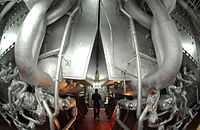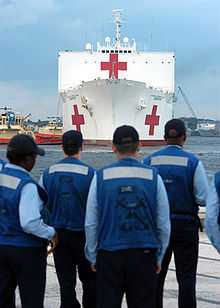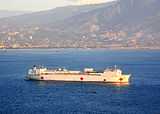USNS Comfort (T-AH-20)
_in_Hati.jpg) Comfort in Haitian waters 2009 | |
| Career | |
|---|---|
| Builder: | National Steel and Shipbuilding |
| Laid down: | May 1, 1975 (as Rose City MA-301) |
| Launched: | February 1, 1976 |
| In service: | December 1, 1987 (with the U.S. Navy) |
| Homeport: | Naval Station Norfolk |
| Status: | in active service, as of 2015 |
| General characteristics | |
| Displacement: | 69,360 tons (70,470 t) |
| Length: | 894 ft (272 m) |
| Beam: | 105 ft 7 in (32.18 m) |
| Propulsion: | two boilers, two GE turbines, one shaft, 24,500 hp (18.3 MW) |
| Speed: | 17.5 knots (20.1 mph; 32.4 km/h) |
| Complement: | 63 civilian, 956 naval hospital staff, 258 naval support staff, up to 1,000 bed patients |
| Time to activate: | 5 days |
| Aviation facilities: | A flight deck that can handle world's largest military helicopters (CH-53D, CH-53E, MH-53E, Mi-17) |
USNS Comfort (T-AH-20) is the third United States Navy ship to bear the name Comfort, and the second Mercy-class hospital ship to join the U.S. Navy's fleet. The USNS prefix identifies the Comfort as a non-commissioned ship owned by the U.S. Navy and operationally crewed by civilians from the Military Sealift Command (MSC). A uniformed naval hospital staff and naval support staff is embarked when Comfort is deployed, said staffs consisting primarily of naval officers from the Navy's Medical Corps, Dental Corps, Medical Service Corps, Nurse Corps and Chaplain Corps, and naval enlisted personnel from the Hospitalman rating and various administrative and technical support ratings (e.g., Yeoman, Personnel Specialist, Information Systems Technician, Religious Program Specialist, etc.).
In keeping with her status as a non-combatant vessel, naval personnel from the "combat" specialties are not assigned as regular crew or staff. Underway embarks by Navy Unrestricted Line officers (e.g., warfare qualified combat specialties), enlisted Naval Aviation, Surface Warfare, Submarine Warfare, Special Operations or Special Warfare/SEAL personnel, or any Marine Corps officers or enlisted personnel, are typically limited to official visits, helicopter or tilt-rotor flight operations or as patients.
In accordance with the Geneva Conventions, USNS Comfort and her crew do not carry any offensive weapons. Firing upon Comfort would be considered a war crime as the ship only carries weapons for self-defense.[1]
Like her sister ship USNS Mercy, Comfort was built as a San Clemente-class oil tanker in 1976 by the National Steel and Shipbuilding Company. Her original name was SS Rose City and she was launched from San Diego, California.
Her career as an oil tanker ended when she was delivered to the U.S. Navy on December 1, 1987. As a hospital ship, Comfort's duties include providing emergency, on-site care for U.S. combatant forces deployed in war or other operations. Operated by the Military Sealift Command, Comfort provides rapid, flexible, and mobile medical and surgical services to support Marine Corps Air/Ground Task Forces deployed ashore, Army and Air Force units deployed ashore, and naval amphibious task forces and battle forces afloat. Secondarily, she provides mobile surgical hospital service for use by appropriate U.S. government agencies in disaster or humanitarian relief or limited humanitarian care incident to these missions or peacetime military operations. Comfort is more advanced than a field hospital but less capable than a traditional hospital on land.[2]
After a quarter-century in Baltimore, Maryland, USNS Comfort changed her homeport to Naval Station Norfolk in Norfolk, Virginia in March 2013. The move placed the ship closer to supplies, much of which come from Naval Medical Center Portsmouth, and to medical crew. Savings to the U.S. Navy are estimated at $2 million per year.[3][4]
General characteristics


_aboard_USNS_Comfort_(T-AH_20).jpg)
- Patient Capacity:
- Intensive care wards: 80 beds
- Recovery wards: 20 beds
- Intermediate care wards: 280 beds
- Light care wards: 120 beds
- Limited care wards: 500 beds
- Total Patient Capacity: 1000 beds
- Operating Rooms: 12
- Departments and Facilities:
- Casualty reception
- Intensive care unit
- Radiological services
- Main laboratory plus satellite lab
- Central sterile receiving
- Medical supply/pharmacy
- Physical therapy and burn care
- Dental services
- Optometry/lens lab
- Morgue
- Laundry
- Oxygen producing plants (two)
- Medical Photography
- Four distilling plants to make drinking water from sea water (300,000 US gallons (1,100,000 l; 250,000 imp gal) per day)
Deployments
Persian Gulf War (1990-91)
During the Persian Gulf War's Operation Desert Storm, Comfort received a call to activate for Desert Shield/Desert Storm Aug. 9, 1990 and departed Baltimore Aug. 11. Comfort was positioned in proximity to Kuwait, just off the coast of Saudi Arabia near Khafji. On March 12, 1991, Comfort was under way on her return trip home. She arrived in Baltimore on April 15, 1991. While deployed, Comfort traveled more than 30,000 nautical miles (35,000 mi; 56,000 km) and consumed almost 3 million U.S. gallons (2,500,000 imp gal; 11,000,000 L) of fuel. More than 8,000 outpatients were seen, and 700 inpatients were admitted including four sailors injured in a high-pressure steam leak on USS Iwo Jima. 337 surgical procedures were performed. Other notable benchmarks include: more than 2,100 safe helicopter evolutions; 7,000 prescriptions filled; 17,000 laboratory tests completed; 1,600 eyeglasses made; 800,000 meals served and 1,340 radiographic studies, including 141 CT scans.
Operation Sea Signal (1994)
Comfort was ordered to activation to serve as migrant processing center for Haitian migrants in 1994. During this mission, Comfort served as the first afloat migrant processing center. She set out for the Caribbean with a crew of 928 military and civilian personnel from various federal government and international agencies. On June 16, 1994 the first Haitian migrants were taken aboard. Over the months deployed, the population onboard swelled to 1,100. Shortly after, Comfort was ordered to discontinue processing and sailed for Guantanamo Bay Naval Base, Cuba to drop off its remaining 400 migrants.
Operation Uphold Democracy (1994)
On September 2, 1994, Comfort was again directed to activate for an unprecedented second deployment. Comfort was tasked to provide a 250-bed medically intensive patient capability for the 35,000 Cuban and Haitian migrants supported by Naval Station Guantanamo Bay, Cuba. Comfort departed Baltimore, with a specially configured crew of 566 personnel. Following the diplomatic agreement reached between the United States and Haiti, Comfort took up a position off Port-au-Prince ready to receive casualties that might result from the transfer of U.S. and allied forces ashore. From September 16 through October 2, 1994, Comfort personnel provided both medical and surgical support to U.S. and allied forces ashore and afloat, emergency humanitarian care to injured Haitian citizens, and participated in various aspects of the Civil Affairs Program in an effort to aid the rebuilding effort of the local healthcare system. She returned to Baltimore on October 14, 1994.
Operation Noble Eagle (2001)

Comfort was activated the afternoon of September 11, 2001, in response to the terrorist attack on the World Trade Center and sailed the next afternoon to serve as a 250-bed hospital facility at Pier 92 in midtown Manhattan. The ship arrived at Pier 92 in Manhattan at about 8:30 p.m. September 14. That evening a small number of relief workers arrived aboard the ship. As word about the ship spread, more workers began arriving over the next few days. The ship's clinic saw 561 guests for cuts, respiratory ailments, fractures, and other minor injuries, and Comfort's team of Navy psychology personnel provided 500 mental health consultations to relief workers.[5] Comfort also hosted a group of volunteer New York area massage therapists who gave 1,359 therapeutic medical massages to ship guests.
Iraq War (2002-03)
Comfort was ordered to activate on December 26, 2002, and set sail for the U.S. Central Command area of operations on January 6, 2003. After stopping in Diego Garcia to embark additional medical personnel flown in from the National Naval Medical Center, the ship proceeded to the Persian Gulf to serve as an afloat trauma center in support of Operation Iraqi Freedom. Comfort remained in the Persian Gulf for 56 days providing expert medical care to wounded U.S. military personnel as well as injured Iraqi civilians and enemy prisoners of war. When Comfort returned to Baltimore on June 12, 2003, it marked the completion of a nearly six-month activation. During this time, the ship conducted more than 800 helicopter deck landings to bring aboard personnel, patients, and cargo. Comfort's Medical Treatment Facility had also performed 590 surgical procedures, transfused more than 600 units of blood, developed more than 8,000 radiographic images, and treated nearly 700 patients, including almost 200 Iraqi civilians and enemy prisoners of war.
Hurricane Katrina (2005)


Comfort deployed on September 2, 2005, after only a two-day preparation, to assist in Gulf Coast recovery efforts after the devastation of Hurricane Katrina. Starting in Pascagoula, Mississippi and then sailing to New Orleans, Comfort personnel saw 1,956 patients total. USNS Comfort returned on October 13, 2005 after its 7 week deployment.
Partnership for the Americas (2007)
USNS Comfort's Partnership for the Americas humanitarian mission, which began on June 15, 2007, was a major component of the President's "Advancing the Cause of Social Justice in the Western Hemisphere" initiative. Comfort visited 12 Central American, South American, and Caribbean nations where its embarked medical crew provided free health care services to communities in need. The missions objective was to offer valuable training to U.S. military personnel while promoting U.S. goodwill in the region. In all, the civilian and military medical team treated more than 98,000 patients, provided 386,000 patient encounters and performed 1,100 surgeries.
The embarked medical crew was made up of more than 500 military and non-governmental organization (Project Hope and Operation Smile) doctors, nurses, and healthcare professionals. Their primary focus was to support medical humanitarian assistance efforts ashore. A secondary mission was outpatient shipboard health service support.
Also supporting Comfort's medical mission was a SEABEE detachment from the East Coast-based Mobile Construction Battalion Maintenance Unit 202, which performed civic action repair and minor construction projects in the host countries. Also on the deployment was the U.S. Navy Showband from Norfolk, Virginia, which performed in each port.
Comfort was operated and navigated by a crew of 68 civil service mariners (CIVMARS) from the U.S. Navy's Military Sealift Command (MSC).
This mission incorporated various non-government organizations and government agencies, such as Operation Smile, Project Hope, LDS Humanitarian Services, the Atlanta Rotary Club, U.S. Air Force, U.S. Coast Guard, U.S. Army, U.S. Health and Human Services and the Canadian Armed Forces.
Patient encounters included a single patient receiving multiple treatments, students in training sessions, and even veterinary care services.
Dentists and staff treated 25,000 patients, extracting 300 teeth, and performing 4,000 fillings, 7,000 sealings, and 20,000 fluoride applications. In addition to treating patients, bio-medical professionals fixed about a thousand pieces of medical equipment at local health facilities. The ship's crew also delivered nearly $200,000 dollars worth of donated humanitarian aid.


Operation Unified Response (2010)
On January 13, 2010, the Comfort was ordered to assist in the humanitarian relief efforts following the 2010 Haiti earthquake as part of Operation Unified Response.[6] Three days later on January 16 the Comfort left the Port of Baltimore bound for Haiti. It arrived Wednesday, January 20, 2010 and began medical treatment early that day.[7][8] The deployment marks the first time the ship has reached full operational capacity, utilizing all 12 operating rooms and beds, since it was delivered to the Navy in 1987.[9] The mission also saw the ship's first on-board delivery, of a 4-pound, 5-ounce premature baby named Esther.[10] Although the ship is less capable than a traditional hospital on land, it offered the most advanced medical care available in Haiti following the earthquake.[2]
Between January 19 and February 28, 2010 the ship's staff treated 1,000 Haitian patients and performed 850 surgeries.[11] As of March 8, USNS Comfort had discharged its last patient.[12] On March 10, the ship ended its mission in the Joint Task Force Haiti area as part of Operation Unified Response, and returned to its home port.[13]
Continuing Promise (2011)
In 2011, the ship deployed on Operation Continuing Promise. For the operation, the ship deployed for five months providing medical and surgical services to nine locations in the Caribbean and Latin America - Jamaica, Peru, Ecuador, Colombia, El Salvador, Nicaragua, Guatemala, Costa Rica, and Haiti.[14] During this mission, the ship's crew set up medical and surgical civil action program sites. These temporary medical clinics included primary care, internal medicine, obstetrics, and pediatric physicians as well as physical therapy, dental, radiology, laboratory, and pharmacy services. On board the ship general surgery, ophthalmology, oral and maxillofacial, and orthopedic surgeries were performed on pre-screened patients.
Awards and decorations
| ||
|
||
|
||
|
||
| 1st Row | |||
|---|---|---|---|
| 2nd Row | |||
| 3rd Row | |||
| 4th Row | Global War on Terrorism Service Medal | Humanitarian Service Medal w/3 service stars | Kuwait Liberation Medal (Kuwait) |
References
- ↑ Diplomatic Conference of Geneva of 1949 "Chapter III: Hospital ships, Article 35 - Conditions not Depriving Hospital Ships of Protection". Retrieved 21 January 2012.
- ↑ 2.0 2.1 Robert Little / The Baltimore Sun (2010-01-25). "Comfort's ability to help stretched to limit". Retrieved 2010-01-26.
- ↑ http://www.med.navy.mil/sites/usnscomfort/Pages/default.aspx
- ↑ http://baltimore.cbslocal.com/2012/02/16/usns-comforts-move-from-baltimore-to-norfolk-to-save-navy-time-money
- ↑ Ellen Maurer, National Naval Medical Center Public Affairs (2003-08-22). "Hospital Ship Receives Humanitarian Medal for September 11 Mission". Retrieved 5 December 2010.
- ↑ Bacon, Lance M. (2010-01-13). "Carl Vinson, 6 Other Ships Headed to Haiti". Navy Times. Retrieved 2010-01-13.
- ↑ Garamone, Jim Garamone / American Forces Press Service (2010-01-16). "Top Navy Doc Predicts Long USNS Comfort Deployment". Retrieved 2010-01-16.
- ↑ Mass Communication Specialist 3rd Class Matthew Jackson, USNS Comfort (T-AH 20) Public Affairs (2010-01-20). "Comfort Receives First Patients". navy.mil. Retrieved 5 December 2010.
- ↑ Robert Little / The Baltimore Sun (2010-01-18). "For USNS Comfort, a chance to prove something". Retrieved 2010-01-26.
- ↑ Robert Little / The Baltimore Sun (2010-01-22). "A baby for the USNS Comfort". Retrieved 2010-01-26.
- ↑ Little, Robert, "Doctors Want Comfort To Stay In Haiti", Baltimore Sun, March 3, 2010.
- ↑ Philip Ewing (8 March 2010). "Navy's Haiti duties winding down". Navy Times. Retrieved 8 March 2010.
- ↑ "US hospital ship Comfort leaving Haiti". Associated Press. 10 March 2010. Retrieved 13 March 2010.
- ↑ Griggs, Travis, "USNS Comfort Heading To Peru", Pensacola News Journal, 27 April 2011.
Notice: This article incorporates material taken from the public domain website of the USNS Comfort at http://www.comfort.navy.mil.
External links
| Wikimedia Commons has media related to USNS Comfort (T-AH-20). |
| ||||||||||||||